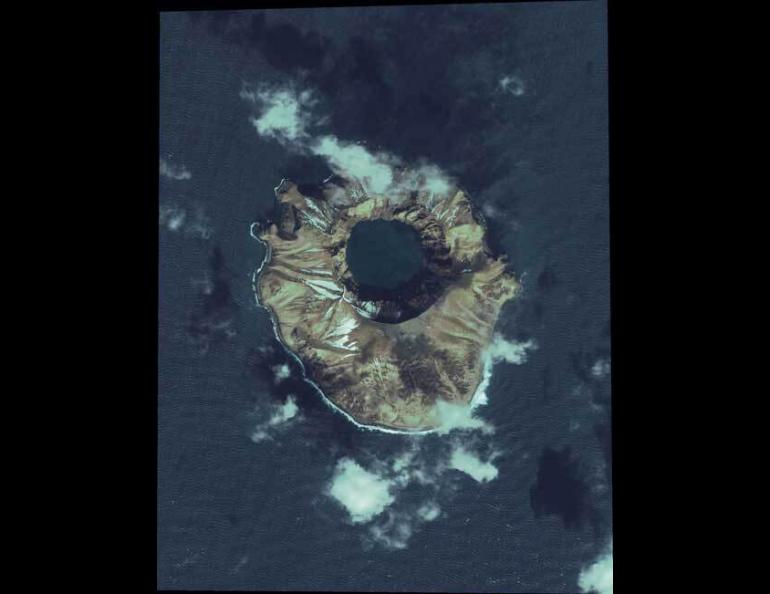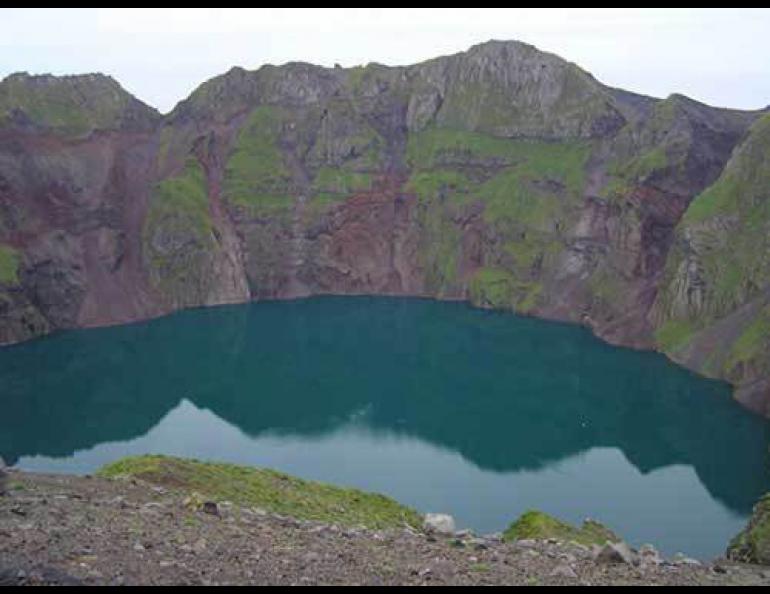

Tiny Aleutian island has big impact
An island smaller than Alaska’s largest airport has frustrated thousands of people trying to get into or out of Alaska. Kasatochi volcano is one of three volcanoes rumbling in the central Aleutians in August 2008, along with Mount Cleveland and Okmok.
Kasatochi, about 80 miles northeast of Adak island in the central Aleutian chain, has spewed an ash cloud that twisted eastward over the North Pacific, scattering planes and canceling flights because pilots know that flying a jet through an ash cloud can cause engines to seize.
Kasatochi is an unlikely source of plane diversion. Before this eruption, the 717-acre green island with slopes that rose steeply to an aquamarine water-filled crater looked like the set of a monster movie. Though biologists saw streams of bubbles in the caldera lake a few years ago, there was no modern record of it erupting. There was one “dodgy report” of the volcano erupting in 1760, but the recent eruption was a “complete and utter surprise,” said Jon Dehn, a volcanologist with the Geophysical Institute.
The eruption was also a shock for two biologists who were studying seabirds on the island for the whole summer. Ray Buchheit and Chris Ford weren’t interested in being interviewed a few days after a charter boat captain got them off the island with only hours to spare, but Alaska Maritime National Wildlife Refuge Supervisory Wildlife Biologist Vernon Byrd described what he knew of the scene:
Buchheit and Ford were staying in a cabin on one of the few relatively flat spots on the island and had felt shaking for a few days. On the day of the eruption, the ground rocked for about 10 minutes straight, and they heard rocks falling within the caldera. They radioed their contact in Adak to let her know.
Refuge staff spoke with scientists at the Alaska Volcano Observatory in Anchorage and decided to hire Al Giddings, a charter boat captain from Adak, to get the biologists off the island, because he could get there before anyone else.
As the island rumbled, Buchheit and Ford had their skiff fueled up and were prepared to jump in and follow a GPS course that would get them to Great Sitkin Island, about 20 choppy miles to the west. Gidding arrived before they had to get in the skiff, and without much time to spare. A few hours after he picked them up, the volcano blew an ash cloud 35,000 feet in the air.
“They were on the Adak side of Great Sitkin when it went,” Byrd said.
A few days after the biologists’ close call, Cathy Cahill, an atmospheric scientist at the Geophysical Institute who was pulling a shift to monitor satellite images of volcanoes, saw the tiny island through the clouds on a satellite image.
“It still exists!” she wrote in her daily report.
Around the same time, Jeff Williams, a biologist for the maritime refuge, sailed by the island on the refuge boat the Tiglax and said the island has a new shape; what were steep cliffs rising from the ocean on the island’s east and west sides now appear to be long, gradual slopes. Though the cloud ceiling was low and the ship couldn’t get close enough for a view of the old fox-trapper’s cabin where the biologists stayed, Williams suspects it no longer exists.
With Kasatochi still shape-shifting and its recent human residents safe in Adak, scientists at the Alaska Volcano Observatory in Anchorage and Fairbanks were busy watching each pass of satellites and the data from seismometers cemented into volcanoes in the central Aleutians, and updating reports on the volcanoes several times a day. The eruptions at three Aleutian volcanoes at once are an interesting coincidence, Dehn said.
“On average, we have an eruption putting ash 20,000 feet in the air seven times a year,” he said. “And we’ve been dry for quite a while.”






